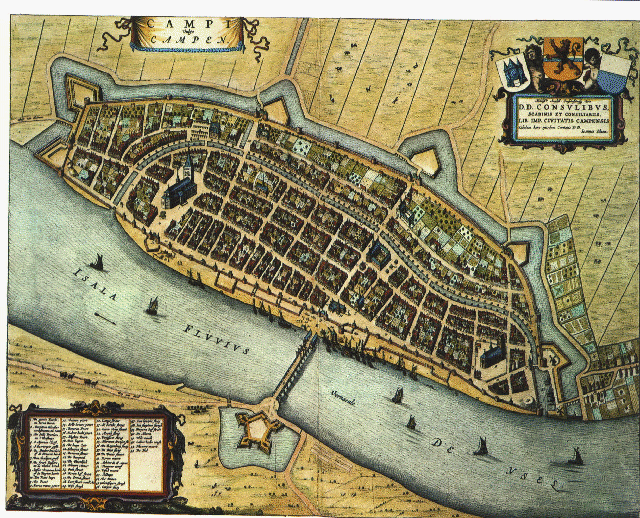
The history of the City of Kampen

This text is of a Dutch city name Kampen, which once sat on the banks of the IJssel river.
In the beginning there was.... Well nobody exactly knows how Kampen arose on the left shore of the river the IJssel. Archeologic research proved that the origin of the settlement is to be seeked towards the end of the eleventh century. In the twelfth century, trade attracted population and the settlement became a city. As a member of the Hanze trade organization, Kampen came to full bloom. But this ended. From the fifthteenth onto the nineteenth century, a period of great unrest made the city fell into decade, from which it never really recovered, not even when industrialization came. Cigar factories dominated the economic live at that time, but now only two are left.
Governmental services left the city in the seventies and now the hospital has to leave due to severe cutbacks in the health care budget, it seems like Kampen has become a mediocre city.
The growth, blossom, decade and modern history of Kampen is reflected in the map. At first people settled on the dyke alongside the river, the newcomers further built their homes around the church that was build against the dyke in the twelfth century. This is the oldest heart of the city. The settlement didn't develop all round the church, though. There are a few streets parallel to the IJssel, intersected by alleys and limited by the town-moat. It seems like the buildings adjusted themselves to the current of the IJssel. The streets stretch from south to west and are intersected by streets in northern direction. This mediaeval ribbon development is still intact, but the town-moat has been reduced in the fifties in order to create more parking space. Much of the town-walls and many monuments have disappeared but the old structure still exists.
In the first half of the thirteenth century Kampen received city rights, a sign that there was a certain density of population and prosperity (the precise moment is unknown; the document was lost in a waterflood). From this time on, Kampen grew. The "city rights" gave the city the independence, which it needed to be able to grow unhindered. Between the thirteenth and fifthteenth century the City of Kampen outshined the other cities in the region.
From 1251 on Kampen received a great deal of privileges that illustrated the importance of Kampen as a city of trade. At first, trade concentrated on Scandinavia, but in the fourteenth century the skippers sailed to Germany, France and England. The greater part of these men weren't merchants but carriers. Kampen had an excellent location and became a center of the carrying-trade.
Initially, the Hanze was a co-operation between merchants from various cities, which arose in the thirteenth century in Germany. This group would get legal protection and trade privileges from the countries. There was in fact a kind of common European markets where certain trade-agreements applied. Gradually the cooperation evolved to an organization of cities. Although a list of members doesn't exist, there are documents that prove that some Dutch cities were in fact members (Kampen, Deventer, Zutphen, Harderwijk etc.). It would happen frequently that the Hanze cities had conflicting interests, but the disputes were almost always settled peacefully by means of a explicit accepted arbitration.
In second half of the fifteenth century, the Hanze came more and more in conflict with the growing tendency towards national and regional care of interests. It was clear that the conservative and protectionistic trade system of the Hanze could not maintain itself. Trade shifted to the Dutch and Zealand cities and the Hanze lost its hegemony, as most of its members lost their importance.
In the fourteenth century Kampen had a fleet of over a hundred ships, bigger than all of the fleets of the Northern Low countries put together. Better ships and navigation instruments led to the exploration of new fields of trade, and the trade shifted onto the Atlantic Ocean. The trade privileges of the Hanze were withdrawn and the center of gravity of the Dutch economy shifted towards the West. Nature also had a part in the decade of the flourishing city. The water-supply of the river the IJssel diminished and so the bigger ships had to avoid the habor. Efforts to improve the level were unsuccessful. Because of the cities efforts to keep its meaning as a city of trade, the industry never exceeded the local market. Towards the end of the eighteenth century only the monuments were left as proof of the great cities rich past.